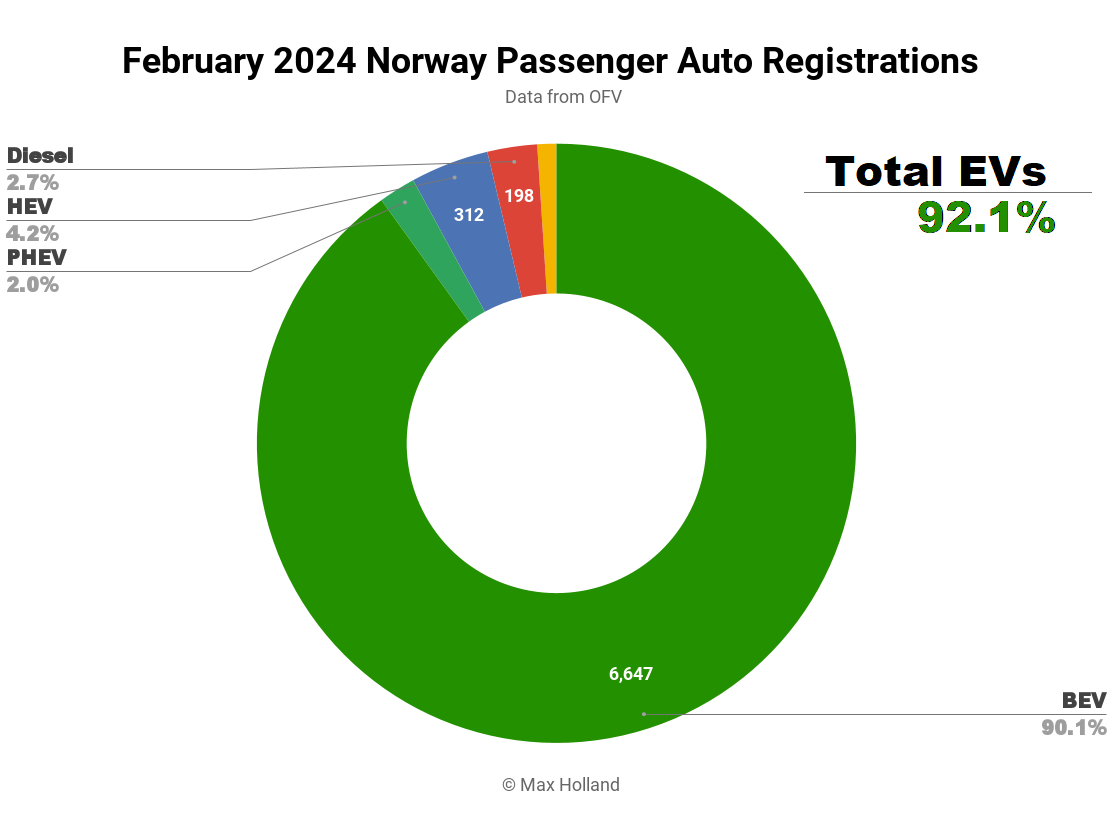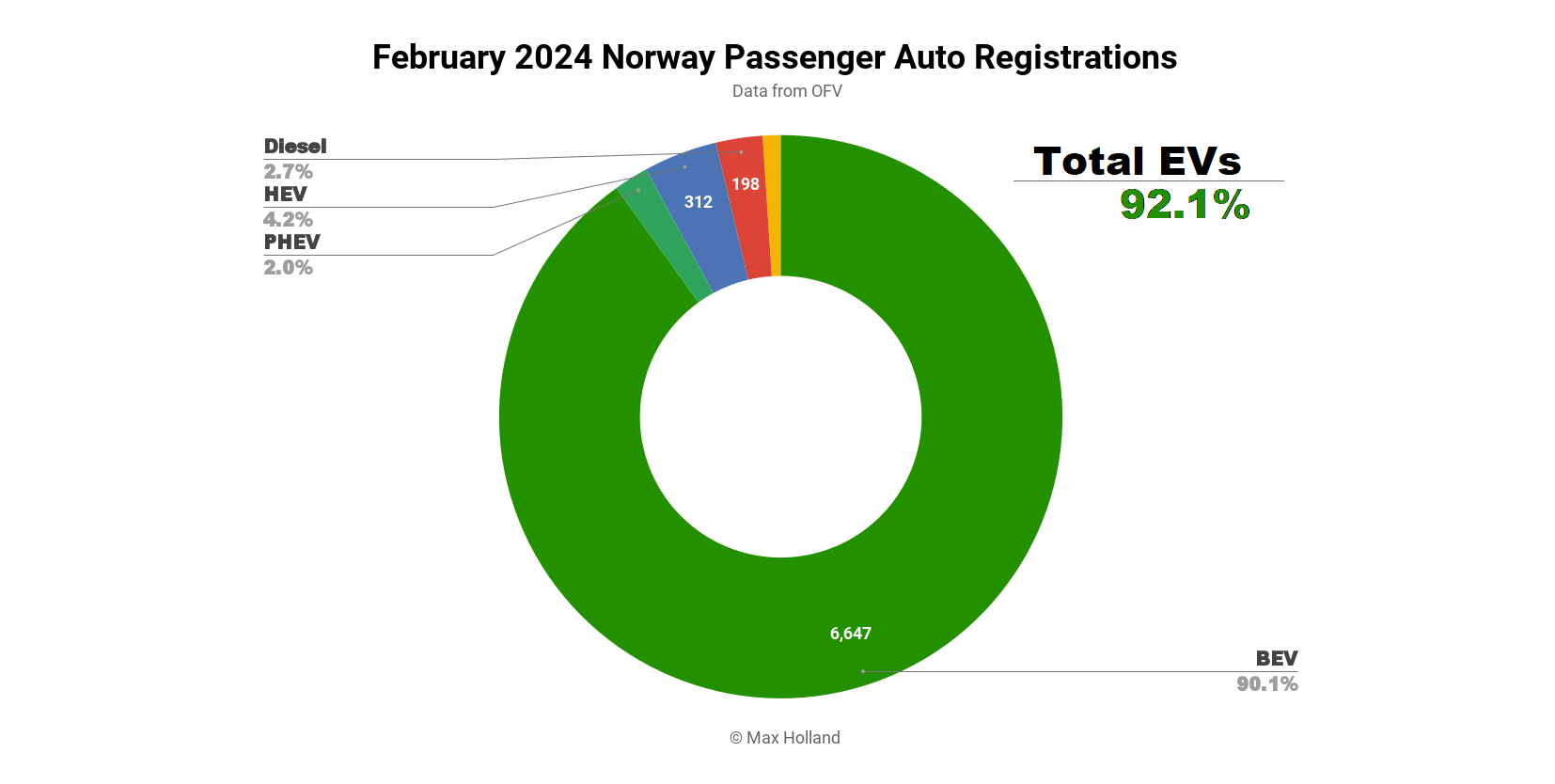February witnessed plugin EVs capturing a remarkable 92.1% share in Norway, up from 90.1% the previous year. With recent tax adjustments, BEVs alone accounted for over 90% share for the second consecutive month. Despite this surge, the overall auto volume remained significantly below seasonal norms, totaling 7,380 units. Notably, the Tesla Model Y accounted for 1,747 units sold, nearly a quarter of the entire market.

February marked a significant milestone with combined EVs achieving a staggering 92.1% market share in Norway, with BEVs constituting 90.1% as full electrics and 2.0% as plugin hybrids. In comparison, the proportions last year were 90.1% combined, with BEVs at 83.1% and PHEVs at 7.0%.
The shift in powertrain balance is a result of recent policy modifications that have led to a decline in non-BEV sales and a subsequent boost in BEV adoption rates. Despite the temporary decrease in PHEV sales, a rebound is expected in the coming months. These changes are aimed at discouraging non-BEV purchases to align with the goal of achieving “100% electric by 2025.” It may take until mid-Q2 to witness a new equilibrium in powertrain distribution.
However, the current scenario in Norway shows a financial strain on the general population, as non-BEVs face higher taxes while affordable BEV options remain limited. The goal of transitioning to 100% BEVs by 2025 may lead to a decline in overall auto sales, potentially hindering access to mobility for working individuals.
Europe lags behind in offering simple, affordable BEVs compared to countries like India, China, and Korea, where BEVs are competitively priced due to decreasing battery cell costs. The absence of affordable BEVs in Europe can be attributed to legacy OEMs maintaining higher BEV prices for short-term gains. This strategy limits the availability of affordable BEVs in European markets.
As the industry continues to grapple with pricing disparities, Norway’s auto market may experience further growth in BEV adoption at the cost of access to affordable vehicles for the general populace. The ongoing dialogue on this transition to EVs and its societal impacts is essential.
Join the discussion on Norway’s auto market trends and the transition to EVs in the comments section below.

Best Selling BEVs
Leading the pack as the best selling vehicle, the Tesla Model Y recorded 1,747 units registered, making up 23.7% of the total auto market, equivalent to the combined sales of the next 7 models.
Following closely were the Volkswagen ID.Buzz and the Toyota BX4x.

The Toyota Group is actively promoting its trio of vehicles – the Toyota BZ4X, Subaru Solterra, and Lexus RZ450E. All three models secured positions in the top 20 for the first time in February, driving notable sales figures.
While several new models such as the BYD Dolphin, Opel Astra, and SsangYong Korando made their debut last month, these vehicles have yet to achieve significant sales volumes.
Additionally, the new BMW iX2, which had one unit registered in January, saw a bump in sales to 28 units in February, pointing towards further growth in the future.
Another new entrant, the Smart #3, debuted with just one unit delivered in February. Its sibling, the Smart #1, launched in September with an average of 6 units/month but also faces limited sales. Both models share a platform with the upcoming Volvo EX30, offering similar technical specifications and pricing.
Discussing the longer-term perspective:

While the Tesla Model Y maintains its lead, other models are witnessing shifts in ranking. The Toyota BZx4 has climbed to the second spot from third in the previous period.
The ID.Buzz has also advanced to third place, up from sixth previously. On the other hand, the Skoda Enyaq, which was a major player in the top 3 over the past two years, dropped to 11th position, indicating a significant decline.
Fleet Powertrain Evolution
An update on the fleet evolution reveals a combined plugin share of 31.39% by the end of December 2023, with BEV share at 24.18%. These figures mark slight increases from three months earlier, signifying a gradual transition. The pace of fleet transition has slowed due to economic downturns impacting auto sales.
Outlook
Aside from the diminishing auto market, Norway’s broader economy struggles, with minimal growth and persistent inflation. The automotive sector faces challenges as rising prices and financial constraints deter individuals from purchasing new vehicles. The ongoing economic instability continues to influence consumer behavior.
Share your insights on Norway’s auto market and the evolving EV trends in the comments section.
Have a tip for CleanTechnica? Want to advertise? Want to suggest a guest for our CleanTech Talk podcast? Contact us here.
Latest CleanTechnica TV Video
CleanTechnica uses affiliate links. See our policy here.


